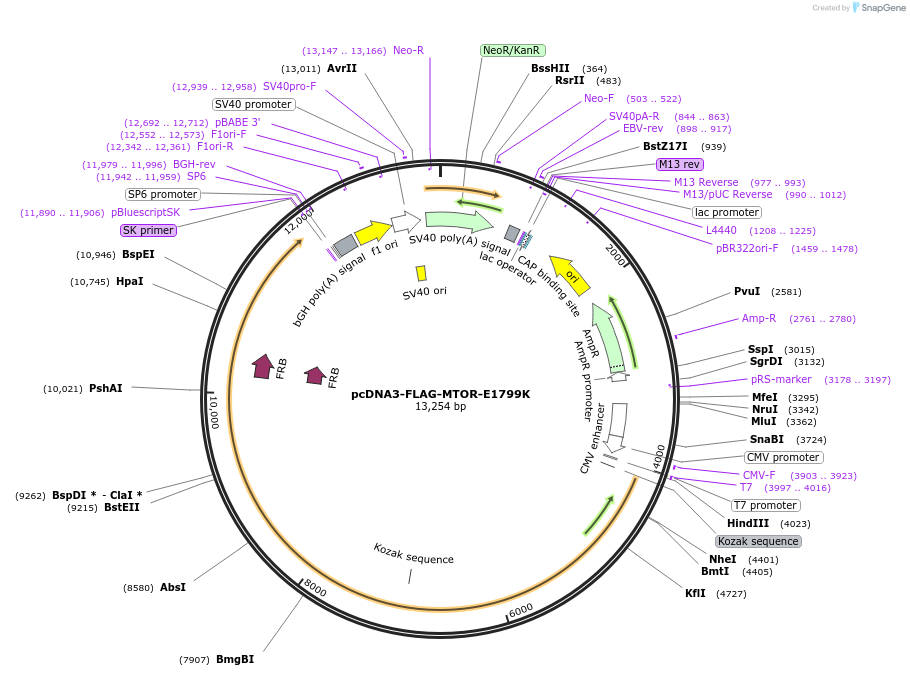-
Purposeactivating MTOR mutation
-
Depositing Lab
-
Sequence Information
Ordering
| Item | Catalog # | Description | Quantity | Price (USD) | |
|---|---|---|---|---|---|
| Plasmid | 69009 | Standard format: Plasmid sent in bacteria as agar stab | 1 | $89 | |
Backbone
-
Vector backbonepcDNA3
- Backbone size w/o insert (bp) 5400
- Total vector size (bp) 13254
-
Vector typeMammalian Expression
-
Selectable markersNeomycin (select with G418)
Growth in Bacteria
-
Bacterial Resistance(s)Ampicillin, 100 μg/mL
-
Growth Temperature37°C
-
Growth Strain(s)DH5alpha
-
Copy numberLow Copy
Gene/Insert
-
Gene/Insert nameMTOR-E1799K
-
Alt nameMTOR (a.k.a. FRAP, FRAP1, FRAP2, RAFT1, RAPT1
-
SpeciesH. sapiens (human)
-
Insert Size (bp)7650
-
Mutationchange Glutamate 1799 to Lysine
-
GenBank IDNM_004958
-
Entrez GeneMTOR (a.k.a. FRAP, FRAP1, FRAP2, RAFT1, RAPT1, SKS)
-
Tag
/ Fusion Protein
- FLAG (N terminal on backbone)
Cloning Information
- Cloning method Unknown
- 5′ sequencing primer CMV-F
- 3′ sequencing primer BGH-rev
- (Common Sequencing Primers)
Resource Information
-
A portion of this plasmid was derived from a plasmid made byAddGene pcDNA3-Flag mTOR wt (Plasmid #26603)
Terms and Licenses
-
Academic/Nonprofit Terms
-
Industry Terms
- Not Available to Industry
Trademarks:
- Zeocin® is an InvivoGen trademark.
Depositor Comments
Activating mutations in MTOR were generated using site-directed mutagenesis on AddGene plasmid 26603 pcDNA3-Flag mTOR wt deposited by Jie Chen lab
Vilella-Bach et al J Biol Chem. 1999 Feb 12. 274(7):4266-72.
These plasmids were created by your colleagues. Please acknowledge the Principal Investigator, cite the article in which the plasmids were described, and include Addgene in the Materials and Methods of your future publications.
-
For your Materials & Methods section:
pcDNA3-FLAG-MTOR-E1799K was a gift from David Sabatini (Addgene plasmid # 69009 ; http://n2t.net/addgene:69009 ; RRID:Addgene_69009) -
For your References section:
A diverse array of cancer-associated MTOR mutations are hyperactivating and can predict rapamycin sensitivity. Grabiner BC, Nardi V, Birsoy K, Possemato R, Shen K, Sinha S, Jordan A, Beck AH, Sabatini DM. Cancer Discov. 2014 May;4(5):554-63. doi: 10.1158/2159-8290.CD-13-0929. Epub 2014 Mar 14. 10.1158/2159-8290.CD-13-0929 PubMed 24631838



